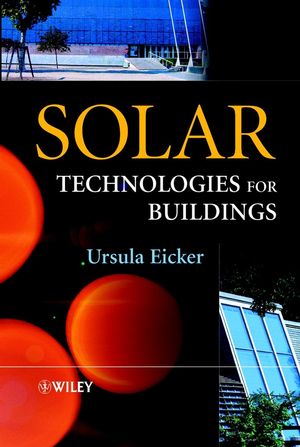Solar Technologies for BuildingsISBN: 978-0-471-48637-4
Hardcover
336 pages
July 2003
 This is a Print-on-Demand title. It will be printed specifically to fill your order. Please allow an additional 10-15 days delivery time. The book is not returnable.
|
||||||
Preface.
Abbreviations in the Text.
1. Solar energy use in buildings.
Energy consumption of buildings.
Meeting requirements by active and passive solar energy use.
2. Solar irradiance.
Extraterrestrial solar irradiance.
The passage of rays through the atmosphere.
Statistical production of hourly irradiance data records.
Global irradiance and irradiance on inclined surfaces.
Shading.
3. Solar thermal energy.
Solar-thermal water collectors.
Solar air collectors.
4. Solar cooling.
Open cycle desiccant cooling.
Closed cycle adsorption cooling.
Absorption cooling technology.
5. Grid connected photovoltaic systems.
Structure of grid connected systems.
Solar cell technologies.
Module technology.
Building integration and costs.
Energy production and the performance ratio of PV systems.
Physical fundamentals of solar electricity production.
Current-voltage characteristics.
PV performance with shading.
Simple temperature model for PV models.
System engineering.
6. Thermal analysis of building-integrated solar components.
Empirical thermal model of building-integrated photovoltaics.
Energy balance and stationary thermal model of ventilated double facades.
Building-integrated solar components (U- and g-values).
Warm-air generation by photovoltaic facades.
7. Passive solar energy.
Passive solar use by glazings.
Transparent themal insulation.
Heat storage by interior building elements.
8. Lighting technology and daylight use.
Introduction to lighting and daylighting technology.
Solar irradiance and light flux.
Luminance and illuminance.
Sky luminance intensity models.
Light measurements.
Daylight distribution in interior spaces.
References.
Index.
Abbreviations in the Text.
1. Solar energy use in buildings.
Energy consumption of buildings.
Meeting requirements by active and passive solar energy use.
2. Solar irradiance.
Extraterrestrial solar irradiance.
The passage of rays through the atmosphere.
Statistical production of hourly irradiance data records.
Global irradiance and irradiance on inclined surfaces.
Shading.
3. Solar thermal energy.
Solar-thermal water collectors.
Solar air collectors.
4. Solar cooling.
Open cycle desiccant cooling.
Closed cycle adsorption cooling.
Absorption cooling technology.
5. Grid connected photovoltaic systems.
Structure of grid connected systems.
Solar cell technologies.
Module technology.
Building integration and costs.
Energy production and the performance ratio of PV systems.
Physical fundamentals of solar electricity production.
Current-voltage characteristics.
PV performance with shading.
Simple temperature model for PV models.
System engineering.
6. Thermal analysis of building-integrated solar components.
Empirical thermal model of building-integrated photovoltaics.
Energy balance and stationary thermal model of ventilated double facades.
Building-integrated solar components (U- and g-values).
Warm-air generation by photovoltaic facades.
7. Passive solar energy.
Passive solar use by glazings.
Transparent themal insulation.
Heat storage by interior building elements.
8. Lighting technology and daylight use.
Introduction to lighting and daylighting technology.
Solar irradiance and light flux.
Luminance and illuminance.
Sky luminance intensity models.
Light measurements.
Daylight distribution in interior spaces.
References.
Index.



